Haibin Wu
Pseudo-Autoregressive Neural Codec Language Models for Efficient Zero-Shot Text-to-Speech Synthesis
Apr 14, 2025Abstract:Recent zero-shot text-to-speech (TTS) systems face a common dilemma: autoregressive (AR) models suffer from slow generation and lack duration controllability, while non-autoregressive (NAR) models lack temporal modeling and typically require complex designs. In this paper, we introduce a novel pseudo-autoregressive (PAR) codec language modeling approach that unifies AR and NAR modeling. Combining explicit temporal modeling from AR with parallel generation from NAR, PAR generates dynamic-length spans at fixed time steps. Building on PAR, we propose PALLE, a two-stage TTS system that leverages PAR for initial generation followed by NAR refinement. In the first stage, PAR progressively generates speech tokens along the time dimension, with each step predicting all positions in parallel but only retaining the left-most span. In the second stage, low-confidence tokens are iteratively refined in parallel, leveraging the global contextual information. Experiments demonstrate that PALLE, trained on LibriTTS, outperforms state-of-the-art systems trained on large-scale data, including F5-TTS, E2-TTS, and MaskGCT, on the LibriSpeech test-clean set in terms of speech quality, speaker similarity, and intelligibility, while achieving up to ten times faster inference speed. Audio samples are available at https://anonymous-palle.github.io.
On The Landscape of Spoken Language Models: A Comprehensive Survey
Apr 11, 2025Abstract:The field of spoken language processing is undergoing a shift from training custom-built, task-specific models toward using and optimizing spoken language models (SLMs) which act as universal speech processing systems. This trend is similar to the progression toward universal language models that has taken place in the field of (text) natural language processing. SLMs include both "pure" language models of speech -- models of the distribution of tokenized speech sequences -- and models that combine speech encoders with text language models, often including both spoken and written input or output. Work in this area is very diverse, with a range of terminology and evaluation settings. This paper aims to contribute an improved understanding of SLMs via a unifying literature survey of recent work in the context of the evolution of the field. Our survey categorizes the work in this area by model architecture, training, and evaluation choices, and describes some key challenges and directions for future work.
Phi-4-Mini Technical Report: Compact yet Powerful Multimodal Language Models via Mixture-of-LoRAs
Mar 03, 2025Abstract:We introduce Phi-4-Mini and Phi-4-Multimodal, compact yet highly capable language and multimodal models. Phi-4-Mini is a 3.8-billion-parameter language model trained on high-quality web and synthetic data, significantly outperforming recent open-source models of similar size and matching the performance of models twice its size on math and coding tasks requiring complex reasoning. This achievement is driven by a carefully curated synthetic data recipe emphasizing high-quality math and coding datasets. Compared to its predecessor, Phi-3.5-Mini, Phi-4-Mini features an expanded vocabulary size of 200K tokens to better support multilingual applications, as well as group query attention for more efficient long-sequence generation. Phi-4-Multimodal is a multimodal model that integrates text, vision, and speech/audio input modalities into a single model. Its novel modality extension approach leverages LoRA adapters and modality-specific routers to allow multiple inference modes combining various modalities without interference. For example, it now ranks first in the OpenASR leaderboard to date, although the LoRA component of the speech/audio modality has just 460 million parameters. Phi-4-Multimodal supports scenarios involving (vision + language), (vision + speech), and (speech/audio) inputs, outperforming larger vision-language and speech-language models on a wide range of tasks. Additionally, we experiment to further train Phi-4-Mini to enhance its reasoning capabilities. Despite its compact 3.8-billion-parameter size, this experimental version achieves reasoning performance on par with or surpassing significantly larger models, including DeepSeek-R1-Distill-Qwen-7B and DeepSeek-R1-Distill-Llama-8B.
CodecFake-Omni: A Large-Scale Codec-based Deepfake Speech Dataset
Jan 14, 2025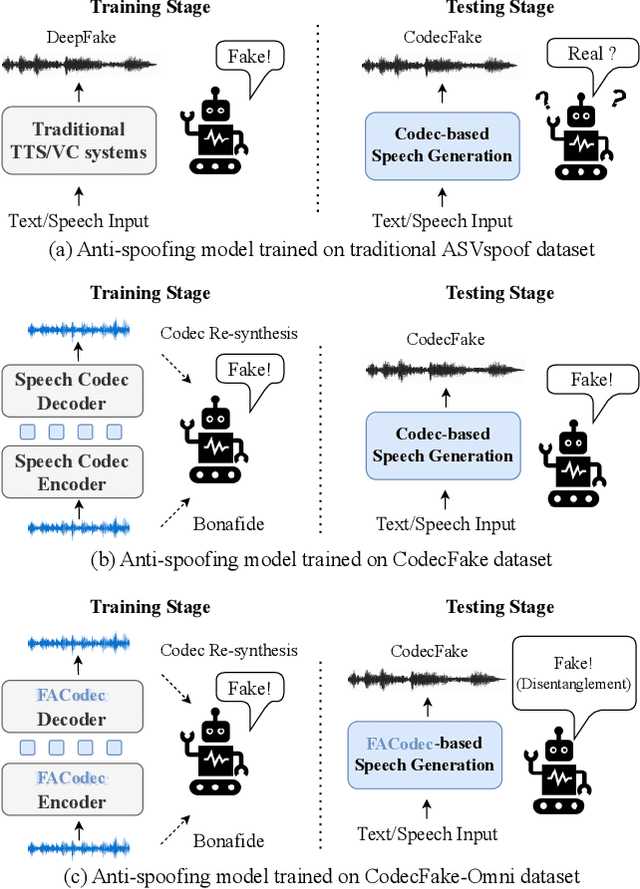
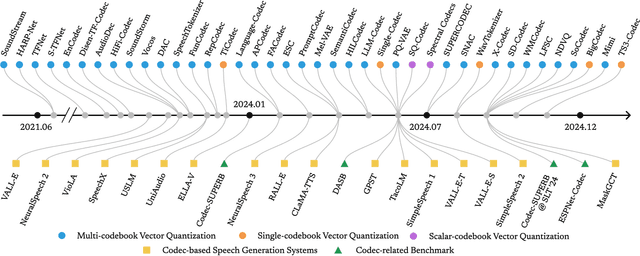

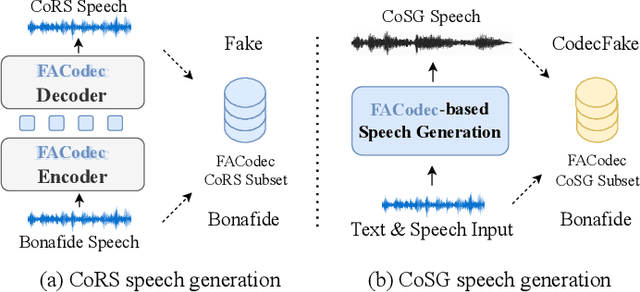
Abstract:With the rapid advancement of codec-based speech generation (CoSG) systems, creating fake speech that mimics an individual's identity and spreads misinformation has become remarkably easy. Addressing the risks posed by such deepfake speech has attracted significant attention. However, most existing studies focus on detecting fake data generated by traditional speech generation models. Research on detecting fake speech generated by CoSG systems remains limited and largely unexplored. In this paper, we introduce CodecFake-Omni, a large-scale dataset specifically designed to advance the study of neural codec-based deepfake speech (CodecFake) detection and promote progress within the anti-spoofing community. To the best of our knowledge, CodecFake-Omni is the largest dataset of its kind till writing this paper, encompassing the most diverse range of codec architectures. The training set is generated through re-synthesis using nearly all publicly available open-source 31 neural audio codec models across 21 different codec families (one codec family with different configurations will result in multiple different codec models). The evaluation set includes web-sourced data collected from websites generated by 17 advanced CoSG models with eight codec families. Using this large-scale dataset, we reaffirm our previous findings that anti-spoofing models trained on traditional spoofing datasets generated by vocoders struggle to detect synthesized speech from current CoSG systems. Additionally, we propose a comprehensive neural audio codec taxonomy, categorizing neural audio codecs by their root components: vector quantizer, auxiliary objectives, and decoder types, with detailed explanations and representative examples for each. Using this comprehensive taxonomy, we conduct stratified analysis to provide valuable insights for future CodecFake detection research.
VERSA: A Versatile Evaluation Toolkit for Speech, Audio, and Music
Dec 23, 2024Abstract:In this work, we introduce VERSA, a unified and standardized evaluation toolkit designed for various speech, audio, and music signals. The toolkit features a Pythonic interface with flexible configuration and dependency control, making it user-friendly and efficient. With full installation, VERSA offers 63 metrics with 711 metric variations based on different configurations. These metrics encompass evaluations utilizing diverse external resources, including matching and non-matching reference audio, text transcriptions, and text captions. As a lightweight yet comprehensive toolkit, VERSA is versatile to support the evaluation of a wide range of downstream scenarios. To demonstrate its capabilities, this work highlights example use cases for VERSA, including audio coding, speech synthesis, speech enhancement, singing synthesis, and music generation. The toolkit is available at https://github.com/shinjiwlab/versa.
TS3-Codec: Transformer-Based Simple Streaming Single Codec
Nov 27, 2024



Abstract:Neural audio codecs (NACs) have garnered significant attention as key technologies for audio compression as well as audio representation for speech language models. While mainstream NAC models are predominantly convolution-based, the performance of NACs with a purely transformer-based, and convolution-free architecture remains unexplored. This paper introduces TS3-Codec, a Transformer-Based Simple Streaming Single Codec. TS3-Codec consists of only a stack of transformer layers with a few linear layers, offering greater simplicity and expressiveness by fully eliminating convolution layers that require careful hyperparameter tuning and large computations. Under the streaming setup, the proposed TS3-Codec achieves comparable or superior performance compared to the codec with state-of-the-art convolution-based architecture while requiring only 12% of the computation and 77% of bitrate. Furthermore, it significantly outperforms the convolution-based codec when using similar computational resources.
Dynamic-SUPERB Phase-2: A Collaboratively Expanding Benchmark for Measuring the Capabilities of Spoken Language Models with 180 Tasks
Nov 08, 2024



Abstract:Multimodal foundation models, such as Gemini and ChatGPT, have revolutionized human-machine interactions by seamlessly integrating various forms of data. Developing a universal spoken language model that comprehends a wide range of natural language instructions is critical for bridging communication gaps and facilitating more intuitive interactions. However, the absence of a comprehensive evaluation benchmark poses a significant challenge. We present Dynamic-SUPERB Phase-2, an open and evolving benchmark for the comprehensive evaluation of instruction-based universal speech models. Building upon the first generation, this second version incorporates 125 new tasks contributed collaboratively by the global research community, expanding the benchmark to a total of 180 tasks, making it the largest benchmark for speech and audio evaluation. While the first generation of Dynamic-SUPERB was limited to classification tasks, Dynamic-SUPERB Phase-2 broadens its evaluation capabilities by introducing a wide array of novel and diverse tasks, including regression and sequence generation, across speech, music, and environmental audio. Evaluation results indicate that none of the models performed well universally. SALMONN-13B excelled in English ASR, while WavLLM demonstrated high accuracy in emotion recognition, but current models still require further innovations to handle a broader range of tasks. We will soon open-source all task data and the evaluation pipeline.
ESPnet-Codec: Comprehensive Training and Evaluation of Neural Codecs for Audio, Music, and Speech
Sep 24, 2024Abstract:Neural codecs have become crucial to recent speech and audio generation research. In addition to signal compression capabilities, discrete codecs have also been found to enhance downstream training efficiency and compatibility with autoregressive language models. However, as extensive downstream applications are investigated, challenges have arisen in ensuring fair comparisons across diverse applications. To address these issues, we present a new open-source platform ESPnet-Codec, which is built on ESPnet and focuses on neural codec training and evaluation. ESPnet-Codec offers various recipes in audio, music, and speech for training and evaluation using several widely adopted codec models. Together with ESPnet-Codec, we present VERSA, a standalone evaluation toolkit, which provides a comprehensive evaluation of codec performance over 20 audio evaluation metrics. Notably, we demonstrate that ESPnet-Codec can be integrated into six ESPnet tasks, supporting diverse applications.
Codec-SUPERB @ SLT 2024: A lightweight benchmark for neural audio codec models
Sep 21, 2024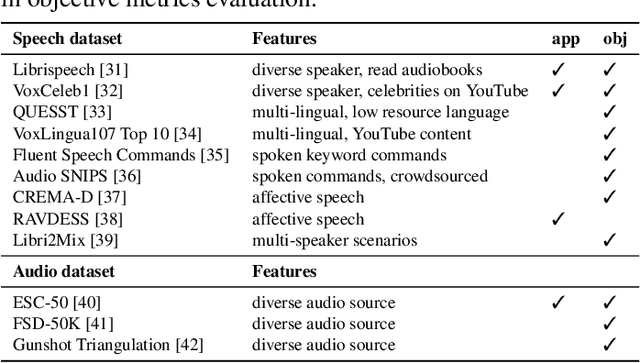
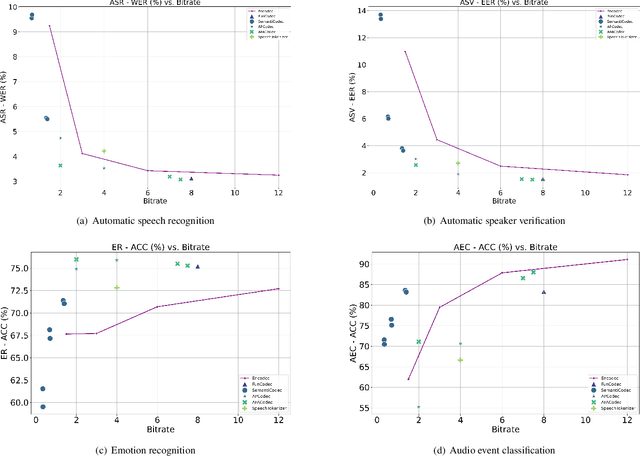
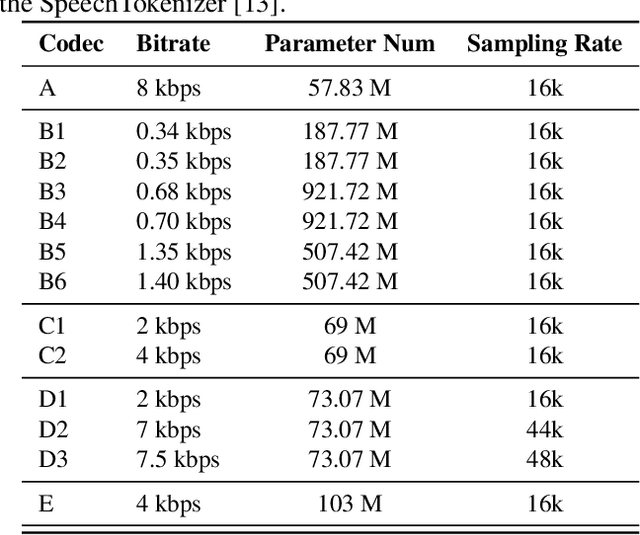
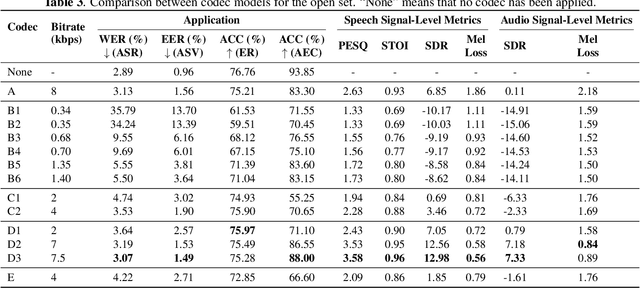
Abstract:Neural audio codec models are becoming increasingly important as they serve as tokenizers for audio, enabling efficient transmission or facilitating speech language modeling. The ideal neural audio codec should maintain content, paralinguistics, speaker characteristics, and audio information even at low bitrates. Recently, numerous advanced neural codec models have been proposed. However, codec models are often tested under varying experimental conditions. As a result, we introduce the Codec-SUPERB challenge at SLT 2024, designed to facilitate fair and lightweight comparisons among existing codec models and inspire advancements in the field. This challenge brings together representative speech applications and objective metrics, and carefully selects license-free datasets, sampling them into small sets to reduce evaluation computation costs. This paper presents the challenge's rules, datasets, five participant systems, results, and findings.
Ultra-Low Latency Speech Enhancement - A Comprehensive Study
Sep 16, 2024Abstract:Speech enhancement models should meet very low latency requirements typically smaller than 5 ms for hearing assistive devices. While various low-latency techniques have been proposed, comparing these methods in a controlled setup using DNNs remains blank. Previous papers have variations in task, training data, scripts, and evaluation settings, which make fair comparison impossible. Moreover, all methods are tested on small, simulated datasets, making it difficult to fairly assess their performance in real-world conditions, which could impact the reliability of scientific findings. To address these issues, we comprehensively investigate various low-latency techniques using consistent training on large-scale data and evaluate with more relevant metrics on real-world data. Specifically, we explore the effectiveness of asymmetric windows, learnable windows, adaptive time domain filterbanks, and the future-frame prediction technique. Additionally, we examine whether increasing the model size can compensate for the reduced window size, as well as the novel Mamba architecture in low-latency environments.
 Add to Chrome
Add to Chrome Add to Firefox
Add to Firefox Add to Edge
Add to Edge